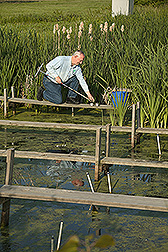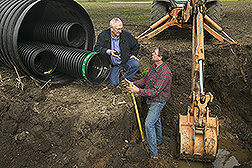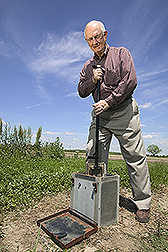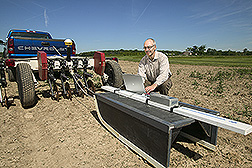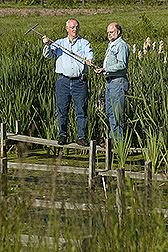Underground Drainage—A Secret of America’s Bounty
America’s Corn Belt wouldn’t be a Corn Belt without underground drainage. These unseen drains, which lie about 3 to 5 feet under more than a third of the Midwest’s farmland, are the reason crops can grow there and people can live there.
Many parts of the Corn Belt, such as northern Ohio, have poorly drained soils—former swamps—that leave fields too cool and wet for planting in early spring. Drainage is essential to economical farming in the region, and it can help reduce flood threats and benefit the environment as well.
The Agricultural Research Service is part of a task force dedicated to updating the nation’s aging drainage systems. It’s called ADMS—Agricultural Drainage Management Systems. It also includes the U.S. Department of Agriculture’s Natural Resources Conservation Service (NRCS) and Cooperative State Research, Education, and Extension Service; the U.S. Geological Survey; state universities and departments of agriculture; local soil and water conservation districts and drainage districts; and farmers.
|
|
A Patchwork of Pipes
American farmers began laying underground drains with pipes in 1878—digging trenches by hand and laying clay pipes one foot at a time. After 1900, manufacturers also sold concrete pipes.
Then, in the late 1960s, farmers switched to the perforated, corrugated plastic pipes that homeowners often use to carry rainwater away from their downspouts. Now, contractors come in with a heavy-duty machine that digs a trench and simultaneously lays 4-inch-diameter plastic pipe—from a big roll—as one continuous piece across a field. More recently, some farmers have begun using a lighter duty machine pulled by their own tractors so they can lay pipe themselves, although not as deep as the more powerful machines can.
Today, the Midwest is crisscrossed by a network of underground pipes—clay, concrete, and plastic—and the surface or roadside ditches they drain into.
The water they carry eventually funnels into streams, lakes, and oceans. With it can flow pollutants like nitrate and phosphorus from fertilizers, along with pesticides and salts.
Midwestern drainage pipes have been blamed for contributing to an annual hypoxic area in the Gulf of Mexico where there’s almost no dissolved oxygen to support aquatic life. It’s said that nitrate from farm drainage systems eventually enters the Gulf via the Mississippi and Atchafalaya Rivers, where it promotes excessive growth of algae, which later dies and uses up oxygen as it decomposes.
Not only does such nutrient loss do environmental harm and violate drinking water standards, but it also wastes farmers’ money.
Starting with the Midwest, the ADMS task force seeks to reduce these risks while saving farmers money by reducing fertilizer loss and increasing crop yields. Some of the improvements under study involve creating new wetlands alongside crop fields or letting farm fields revert to natural wetlands during the off-season.
|
|
Control Stops Trouble
That is the future of farm drainage as soil scientist Norm Fausey sees it. He heads research at the ARS Soil Drainage Research Unit in Columbus, Ohio. It’s becoming possible because the historical practice of allowing water to flow from the drains year-round is being changed, based on research. This major innovation allows farmers to control when—and at what water level—water will flow through the drainage pipes.
Contractors attach an adjustable, in-line control structure to the drainage pipes in one or more parts of a field. These structures allow the farmer to periodically adjust the height the water table must reach in the soil profile before triggering drainage. Commercially available structures offer either stacked flashboard risers or floats to adjust this water level. Water level is set high during winter and at other times when no crops are growing; low during planting and harvesting periods; and at intermediate levels during the growing season, depending on the crop, its growth stage, and amount of precipitation that occurs.
Farmers can raise and lower the drainage control height in the structure, depending on what farm operations they are doing and what season it is, being careful to not overdrain or underdrain their fields. NRCS recommends draining fields in the spring only enough to allow a tractor to drive on them for tilling and planting.
The task force issued a report on controlled drainage—based largely on research in Illinois, North Carolina, and Ohio—that showed reductions in flow of nitrate and water off fields. Fausey and ARS agricultural engineers Kevin King and Barry Allred are now in the sixth year of doing studies in northwest Ohio along with Ohio State University-Columbus (OSU) scientists Larry Brown and Andy Ward.
“We’re finding that controlled drainage can reduce nitrate losses by 45 percent and drain 40 percent less water. The results are similar in the other Midwest studies and earlier studies in North Carolina,” Fausey says.
In Illinois, Donald Pitts, the state water quality specialist and NRCS agricultural engineer; Richard Cooke, who is with the University of Illinois; and Paul Terio, a U.S. Geological Survey water quality specialist, used an ARS-supported computer model called DRAINMOD to show that nitrate loads could be reduced 35 percent if farmers controlled drainage level at 1 foot below the soil surface during the off-season.
What Goes Around Comes Around
In cooperation with Brown and NRCS’s Bernie Czartoski, Fausey devised the idea of recycling drainage water to use for irrigating crops. The water is filtered through artificial wetlands before being stored in a reservoir until needed.
Plants in the wetlands take nitrate out of the water and use it to grow. Sediment and attached contaminants in the water also settle out in the wetlands. Since little water is discharged from the field to area streams, less nitrate, sediment, and other pollutants leave the area.
The “Wetland Reservoir Subirrigation System,” as it’s known, maintains a constant water table under crops throughout the growing season. To irrigate fields during the hottest and driest weather, farmers pump stored drainage water back through the drainage pipes. This way, crops always have water readily available; it resembles the fine-tuned watering done in a greenhouse system.
At three sites in Ohio where this has been tested for several years, corn yields went up 48 percent and soybean yields increased 40 percent in years with below-normal rainfall.
Sharing the Costs and Benefits
NRCS has made drainage management its top water issue. More states are adopting the agency’s revised practice standard for design and operation of drainage water management and offering cost-sharing for installing the structures and equipment needed for controlled drainage or subirrigation with recycled drainage water.
Based on demonstrations and research results, North Carolina included controlled drainage as one of three ways farmers can meet a state law requiring that any water drained from fields must meet drinking-water standards. North Carolina offers to pay a share of the costs of farmers’ installing controlled drainage. USDA’s Farm Services Agency offers similar, but federal, cost-share funds in Illinois.
How To Find the Old Pipes?
A decade of experience with harvestor-mounted yield monitors has shown farmers how much their yields drop in the wet areas between widely spaced drainage pipes. So farmers are adding more pipes all the time—placing them closer together and running them under entire fields, sometimes at shallower depths.
But with a century-old underground system that may have been added onto by a variety of farmers, it can be difficult to know where old pipes lie.
Contractors have two ways of finding them: probing the ground with a rod or using a backhoe to dig a trench across a field. Both can damage plastic pipes, and neither is efficient.
|
|
Under a grant from OSU’s Ohio Agricultural Research and Development Center in Columbus, ARS agricultural engineer Barry Allred has found that ground-penetrating radar works better and doesn’t harm existing pipes. At 13 test sites, he located buried pipes with 72-percent accuracy overall. In six plots, he found all of them.
Allred uses a unit that looks like a lawnmower. But he recommends that the equipment be mounted on a sled and dragged across a field by a vehicle or tractor. He’s worked on this for the past few years, branching out to search for drainage pipes under golf courses, which also need to be drained in wet regions.
Allred is also working with Fausey on the reuse system, researching how to improve water-treatment efficiency and to develop management recommendations for growers under different soil and weather conditions.
Surrounding Pipes With Wood Chips
Dan Jaynes, an ARS task-force researcher in Iowa, has another nitrate-lowering improvement. Without installing controlled drainage, he cuts nitrate loss by two-thirds by digging a trench alongside existing pipes and filling it with wood chips.
Jaynes digs the trenches down to 6 feet, adds 4 feet of wood chips, and covers with 2 feet of soil. Farmers can farm over the trenches just like the rest of the field.
The wood chips serve as a carbon filter. “Actually, they’re tiny bioreactors,” Jaynes says. “Microbes feed on carbon in the wood and, in the anaerobic conditions below the water table, use nitrate in the drainage water as a substitute for oxygen.”
Eventually, if the successes continue, Jaynes will explore engineering designs that might allow farmers to lay new pipes directly in the wood-chip trenches. He has also considered combining the trenches with controlled drainage and subirrigation, further cutting nitrate losses.
Adoption of innovations such as these should soon lead to improved drainage systems for the nation’s breadbasket.—By Don Comis, Agricultural Research Service Information Staff.
This research is part of Water Quality and Management, an ARS National Program (#201) described on the World Wide Web at http://www.ars.usda.gov/research/programs.htm.
Norman R. Fausey and Barry J. Allred are in the USDA-ARS Soil Drainage Research Unit, 590 Woody Hayes Dr., Columbus, OH 43210-1058; phone (614) 292-9806, fax (614) 292-9448.
Dan B. Jaynes is with the USDA-ARS National Soil Tilth Laboratory, 2150 Pammel Dr., Ames, IA 50011-3120; phone (515) 294-8243, fax (515) 294-8125.
"Underground Drainage—A Secret of America’s Bounty" was published in the September 2005 issue of Agricultural Research magazine.







